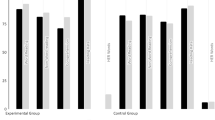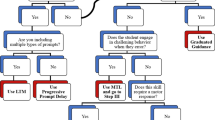Abstract
Behavioral treatment plans are developed and implemented to enhance an individual’s skills or reduce maladaptive behavior. Often, they are written by doctoral-level psychologists and implemented by direct care staff. However, recent research on readability suggests that behavioral plans may not be implemented as designed because the direct care staff that implements them may not be able to fully understand or read the plans as they are written. The purposes of our study were to analyze the readability and reading level of 20 behavior treatment plans written by professional staff and to determine if the plans were understandable and written at an acceptable reading level. We used the RAIN to assess 20 randomly selected behavioral treatment plans for readability and the SMOG formula to assess reading level. Results showed that none of the treatment plans met all 12 criteria for readability examined by the RAIN. Further, reading levels of the plans measured by the SMOG ranged from 12 to 16 suggesting that an average reading level of 14 was required to read them. These results suggest that behavioral treatment plans are not being written in a manner that facilitates understanding by direct care staff and are written at six grade levels higher than the reading level of an average American. Our findings indicate an urgent need for psychologists to write behavioral treatment plans at least at the reading level of the staff who are entrusted to implement them.
Similar content being viewed by others
References
Adkins, A. D., & Singh, N. N. (2001). Reading level and readability of patient education materials in mental health. Journal of Child and Family Studies, 10, 1–8. doi:10.1023/A:1016617115729.
Adkins, A. D., Singh, N. N., McKeegan, G. F., Laneir, A. E., & Oswald, D. P. (2002). Behavior treatment programs, readability, and treatment outcomes. Research in Developmental Disabilities, 23, 253–265. doi:10.1016/S0891-4222(02) 00121-X.
Adkins, A. D., Elkins, E. N., & Singh, N. N. (2001). Readability of NIMH easy-to-read patient education materials. Journal of Child and Family Studies, 10, 279–285. doi:10.1023/A:1012563808389.
Blonigen, B. A., Harbaugh, W. T., Singell, L. D., Horner, R. H., Irvin, L. K., & Smolkowski, K. S. (2008). Application of economic analysis to school-wide positive behavior support (SWPBS) programs. Journal of Positive Behavior Interventions, 10, 5–19. doi:10.1177/1098300707311366.
Harvey, V. S. (1997). Improving readability of psychological reports. Professional Psychology, Research and Practice, 28, 271–274. doi:10.1037/0735-7028.28.3.271.
King, M. M., Winton, A. S. W., & Adkins, A. D. (2003). Assessing the readability of mental health brochures for children and adolescents. Journal of Child and Family Studies, 12, 91–99. doi:10.1023/A:1021362210470.
Kirkpatrick, M. F., & Mohler, C. (1999). Using the readability assessment instrument to evaluate patient medication leaflets. Drug Information Journal, 33, 557–563.
Lancioni, G. G. E., Singh, N. N., O’Reilly, M. F., & Sigafoos, J. (2009). An overview of behavioral strategies for reducing hand-related stereotypies of persons with severe to profound intellectual and multiple disabilities: 1995–2007. Research in Developmental Disabilities, 30, 20–43. doi:10.1016/j.ridd.2008.02.002.
Luiselli, J. K. (2006). Antecedent assessment and interventions: Supporting children and adults with developmental disabilities in community settings. Baltimore, MD.: Paul H. Brookes.
McKeegan, G. F., Laneir, A. E., Adkins, A. D., Amato, J. L., Elkins, E. L., & Lugar, S. B. (2002). Reading grade level and readability of behavior treatment programs for individuals with disabilities. Behavior Therapist, 25, 169–171.
McLaughlin, G. H. (1969). SMOG grading − a new readability formula. Journal of Reading, 12, 639–646.
National Center for Educational Statistics.(2003). National Assessment of Adult Literacy (NAAL): A first look at the literacy of America’s adults in the 21st century. Washington, DC: U.S. Department of Education, Institute of Education Sciences.
Richardson, J. S., & Morgan, R. F. (1994). Reading to learn in the content areas. Belmont, CA: Wadsworth Publishing Co.
Rousseau, M. K., & Foshee, J. G. (1981). Increasing reading comprehension of direct care trainees. Mental Retardation, 19, 169–172.
Singh, A. N. (1999). Readability of behavioral treatment programs in mental health. Journal of Child and Family Studies, 8, 369–357. doi:10.1023/A:1021927001642.
Singh, J. (1995). The readability of educational materials written for parents of children with attention-deficit hyperactivity disorder. Journal of Child and Family Studies, 4, 207–218. doi:10.1007/BF02234096.
Singh, J. (2003). Readability Assessment Instrument (RAIN) Users Manual. Chesterfield, VA: One Publications.
Wilson, F. L. (1996). Patient education materials nurses use in community health. Western Journal of Nursing Research, 18, 195–205. doi:10.1177/019394599601800207.
Zaharia, E. S., & Baumeister, A. A. (1978). Estimated position replacement costs for technician personnel in a state’s public facilities. Mental Retardation, 16, 131–134.
Author information
Authors and Affiliations
Corresponding author
Rights and permissions
About this article
Cite this article
Singh, A.N., Matson, J.L., Cooper, C.L. et al. Readability and Reading Level of Behavior Treatment Plans in Intellectual Disabilities. J Dev Phys Disabil 21, 185–194 (2009). https://doi.org/10.1007/s10882-009-9134-z
Published:
Issue Date:
DOI: https://doi.org/10.1007/s10882-009-9134-z




